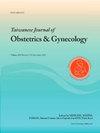胎儿镜激光消融术中微创手术避免双胎输血综合征伴前壁胎盘损伤1例:供体双胎并发肾发育不良伴肾束绕干1例并文献复习
IF 2.2
4区 医学
Q2 OBSTETRICS & GYNECOLOGY
引用次数: 0
摘要
目的:双胎输血综合征(TTTS)是单绒毛膜(MC)双胞胎的一种特殊并发症,胎盘内血管吻合口血流不平衡,导致血流动力学紊乱,可能对围产期结局产生不利影响。TTTS的最初临床表现可能是供体双胞胎(“被攻击的”双胞胎)的低血容量和少尿,而在产前超声下,受体双胞胎的高血容量和尿尿。然而,如果不及时治疗,死亡率可达90%。胎儿镜激光消融(FLA)被认为是TTTS的黄金治疗标准。然而,前壁胎盘的FLA在技术上具有挑战性。病例报告一名初产妇在妊娠17周时被诊断为TTTS III期。本文报道一例MC双胎妊娠合并TTTS合并前壁胎盘的胎儿镜激光凝固术中,采用详细的术前计划和改良的小剖腹入路避免血管损伤。在FLA手术期间和之后没有并发症。在随访中,“卡住”的双胞胎表现为胎儿生长不良,怀疑双侧肾脏发育不良和躯干绕索。病例因母体镜像综合征于妊娠26+2周分娩,而供体双胎产后确诊先天性肾发育不良,在分期时可增加TTTS的严重程度。供体双胞胎在我们的新生儿重症监护室18天后死亡。受赠双胞胎在住院120天后顺利出院,发育正常。我们的研究结果也强调了在单绒毛膜双羊膜双胎妊娠中与TTTS共存的罕见情况,导致预后较差。结论根据患者和胎儿的临床症状,制定详细的术前计划,及时采取干预措施,终止妊娠,可预防不良结局。本文章由计算机程序翻译,如有差异,请以英文原文为准。
Mini-laparotomy to avoid vascular injury during fetoscopic laser ablation in a case of twin–twin transfusion syndrome with anterior wall placenta: Report of a case complicated with renal dysplasia and cord-around-trunk in donor cotwin and review of the literature
Objective
Twin–twin transfusion syndrome (TTTS) is a special complication of monochorionic (MC) twins, with unbalanced flows through vascular anastomoses within the placenta, causing hemodynamic derangement that can adversely affect perinatal outcome. The initial clinical manifestations of TTTS may be hypovolemic and oliguric of the donor cotwin (the "struck" twin), and hypervolemia and polyureic of the recipient cotwin under prenatal ultrasound. However, the mortality rate can reach 90 % if left untreated. Fetoscopic laser ablation (FLA) is considered the golden treatment standard of TTTS. However, FLA is technically challenging in cases with anterior wall placenta.
Case report
A primigravida woman was diagnosed with TTTS stage III at 17 weeks of gestation. A detailed preoperative plan and a modified mini-laparotomy approach were used to avoid vascular injury during fetoscopic laser coagulation (FLA) in a case of MC twins pregnancy complicated by the TTTS with anterior wall placenta. There were no complications during and after the FLA procedure. During follow-up, the "stuck" twin showed poor fetal growth with the suspicion of bilateral renal dysplasia and cord-around-trunk. The case delivered at 26+2 weeks of gestation due to maternal mirror syndrome, while donor cotwin was confirmed to have congenital renal dysplasia postnatally, which could increase the severity of TTTS when staging. The donor cotwin died after 18 days in our neonatal intensive care unit. While the recipient cotwin was discharged smoothly after 120 days of hospitalization with normal development. Our findings also highlighted a rare condition coexistence with TTTS in monochorionic diamniotic twin pregnancy, leading to a poorer prognosis.
Conclusion
Timely interventions with a detailed preoperative plan and termination of pregnancy according to the clinical symptoms of both the patient and the fetuses may prevent dismal outcome.
求助全文
通过发布文献求助,成功后即可免费获取论文全文。
去求助
来源期刊

Taiwanese Journal of Obstetrics & Gynecology
OBSTETRICS & GYNECOLOGY-
CiteScore
3.60
自引率
23.80%
发文量
207
审稿时长
4-8 weeks
期刊介绍:
Taiwanese Journal of Obstetrics and Gynecology is a peer-reviewed journal and open access publishing editorials, reviews, original articles, short communications, case reports, research letters, correspondence and letters to the editor in the field of obstetrics and gynecology.
The aims of the journal are to:
1.Publish cutting-edge, innovative and topical research that addresses screening, diagnosis, management and care in women''s health
2.Deliver evidence-based information
3.Promote the sharing of clinical experience
4.Address women-related health promotion
The journal provides comprehensive coverage of topics in obstetrics & gynecology and women''s health including maternal-fetal medicine, reproductive endocrinology/infertility, and gynecologic oncology. Taiwan Association of Obstetrics and Gynecology.
 求助内容:
求助内容: 应助结果提醒方式:
应助结果提醒方式:


